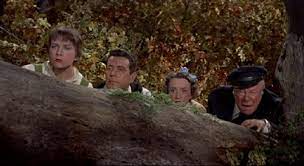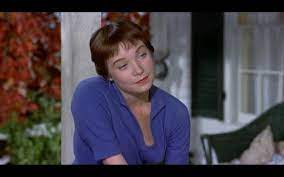← Back to Reviews
in
The Trouble with Harry
Long before he established himself as the king of cinematic suspense, Alfred Hitchcock scored with a practically forgotten black comedy/murder mystery from 1955 called The Trouble with Harry, that provided delicious entertainment, even though today it is best known for being the film debut of a future movie legend, though it has so much more to offer.

The setting of this little gem is a small mountain town in Vermont where we meet a retired tugboat captain named Wiles, who is out hunting and thinks he has accidentally shot a man named Harry. Wiles wants to dispose of the body, but before he can, the body is discovered by a lonely spinster named Miss Gravely, who has been harboring a crush on Wiles, a young widow named Jennifer and her son, a bum who steals Harry's shoes, a nearsighted doctor who trips over the body without realizing what it is, and a handsome artist named Sam, none of whom seem terribly upset about the man's death or about reporting it to the authorities.

Hitchcock is given a quietly brilliant screenplay to work with provided by longtime collaborator John Michael Hayes, who wrote the screenplays for Rear Window, The Man Who Knew Too Much, and Marnie, that brings a quiet lyric quality in its establishing of small town atmosphere, while at the same time, providing a perverse indifference to the death of a man who may or may not deserve it. The viewer is simultaneously confused and amused as not only a connection to Harry is revealed through the characters we meet, but an unseemly obsession to keeping Harry's death a secret, which actually finds the folks involved having to bury, dig up, and re-bury the body more than once. Just as the viewer has settled into these people's indifference toward poor Harry, it's implied that Harry's spirit might not be happy about the way his body is being treated.

The story implies that Harry may have gotten what's coming to him, but never completely commits to it while the concept of murder is seemingly whitewashed, the same way it was in a previous Hitchcock classic called Rope, that also takes the concept of getting away with murder and almost legitimizes it, but the screenplay provides just enough contrivances and Hitchcock provides just enough of his uncanny storytelling skill that the viewer almost forgets that the murder of a human being is being covered up here.

Hitchcock covers the almost indecency of what is going on here with handsome production values, including gorgeous color photography, that only enhances the perversity of what's going on here. Hitchcock also seems to have assembled a perfect ensemble cast to pull off this story with standout work from Oscar winner Edmund Gwenn as the befuddled Captain Wiles, John Forsythe as the young artist, Mildred Natwick as the lonely spinster, and making an appealing film debut as the widow Jennifer, future Oscar winner Shirley MacLaine. And if the young boy playing her son looks familiar, that's because it's the future Beaver Cleaver, young Jerry Mathers. Another underrated gem from Alfred Hitchcock that never got the attention it deserved.
Long before he established himself as the king of cinematic suspense, Alfred Hitchcock scored with a practically forgotten black comedy/murder mystery from 1955 called The Trouble with Harry, that provided delicious entertainment, even though today it is best known for being the film debut of a future movie legend, though it has so much more to offer.

The setting of this little gem is a small mountain town in Vermont where we meet a retired tugboat captain named Wiles, who is out hunting and thinks he has accidentally shot a man named Harry. Wiles wants to dispose of the body, but before he can, the body is discovered by a lonely spinster named Miss Gravely, who has been harboring a crush on Wiles, a young widow named Jennifer and her son, a bum who steals Harry's shoes, a nearsighted doctor who trips over the body without realizing what it is, and a handsome artist named Sam, none of whom seem terribly upset about the man's death or about reporting it to the authorities.

Hitchcock is given a quietly brilliant screenplay to work with provided by longtime collaborator John Michael Hayes, who wrote the screenplays for Rear Window, The Man Who Knew Too Much, and Marnie, that brings a quiet lyric quality in its establishing of small town atmosphere, while at the same time, providing a perverse indifference to the death of a man who may or may not deserve it. The viewer is simultaneously confused and amused as not only a connection to Harry is revealed through the characters we meet, but an unseemly obsession to keeping Harry's death a secret, which actually finds the folks involved having to bury, dig up, and re-bury the body more than once. Just as the viewer has settled into these people's indifference toward poor Harry, it's implied that Harry's spirit might not be happy about the way his body is being treated.
The story implies that Harry may have gotten what's coming to him, but never completely commits to it while the concept of murder is seemingly whitewashed, the same way it was in a previous Hitchcock classic called Rope, that also takes the concept of getting away with murder and almost legitimizes it, but the screenplay provides just enough contrivances and Hitchcock provides just enough of his uncanny storytelling skill that the viewer almost forgets that the murder of a human being is being covered up here.
Hitchcock covers the almost indecency of what is going on here with handsome production values, including gorgeous color photography, that only enhances the perversity of what's going on here. Hitchcock also seems to have assembled a perfect ensemble cast to pull off this story with standout work from Oscar winner Edmund Gwenn as the befuddled Captain Wiles, John Forsythe as the young artist, Mildred Natwick as the lonely spinster, and making an appealing film debut as the widow Jennifer, future Oscar winner Shirley MacLaine. And if the young boy playing her son looks familiar, that's because it's the future Beaver Cleaver, young Jerry Mathers. Another underrated gem from Alfred Hitchcock that never got the attention it deserved.
